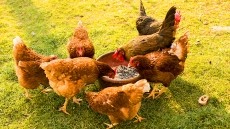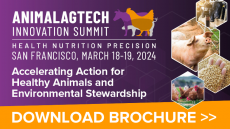Feature: Protein innovation
Green Plains and Houdek look to unlock potential of fermented protein

They are developing novel inputs aimed at enhancing the sustainability and nutritional quality of feed, primarily for use in fish farming and in pet food.
Fermented corn protein
Green Plains, originally an ethanol producer, has transformed its business in recent years into a sustainable biorefinery. In 2018, it launched a strategic plan to shift focus towards high-protein ingredients, shedding non-core assets and forming key partnerships. By mid-2020, its biorefinery in Shenandoah, Iowa, shipped its first batch of Ultra-High Protein, boasting over 50% protein content and high digestibility. In April 2023, Green Plains introduced Sequence, a plant-based protein ingredient combining corn and yeast, with 60% protein content.
Louis Rens, senior vice president of global ingredient sales at Green Plains, tells us that global expansion is a key driver of the company's high-protein strategy.
“We've always believed that expanding internationally would help mitigate our risks by diversifying our customer base. When I started in 2021, our corporate strategy was relying on significant growth of the protein business, with five new production facilities planned. We undertook a deep-dive market analysis to determine where our protein products could fit. I worked closely with our nutrition and commercial teams to pinpoint potential markets, and we identified several promising opportunities. We regularly conduct these analyses to capture emerging market trends and track our execution progress. Many feed companies are still unaware of our product portfolio, providing significant opportunities for growth.
“One example is shrimp, which requires high-protein diets. The industry has been shifting away from marine proteins like fishmeal and increasingly incorporating plant proteins. Our goal was to capture a share of this plant protein market. Similarly, for rainbow trout, the industry has reduced marine protein usage, and processed animal proteins, such as poultry byproduct meal, have proven to be both effective and cost-efficient, although not universally accepted across all regions.
“We've also entered new segments like sea bass, sea bream, and tilapia in areas where fewer ingredient options exist, and we can offer affordable plant-based alternatives that replace more expensive animal proteins. In the salmon market, which demands high protein levels due to the carnivorous nature of the fish, we offer both our Ultra-High Protein and Sequence ingredients, providing flexibility depending on how the producers manage their protein needs.”
Conversely, Green Plains avoids markets like poultry layer diets, where the economics don’t favor their ingredient.
“The price of eggs is too low to justify the inclusion of our proteins. Formulators tend to work with a ‘basket’ of ingredients, adjusting based on the available supply of options like soybean meal, canola meal, poultry byproduct meal, and wheat. Sometimes our ingredients fit into their formulas; other times, they don't. In broiler diets, we have a presence in some regions but not others, depending on the availability of local ingredients.”
So, the strategy has been to diversify across various animal segments, but with a particular focus on aquaculture and pet food, especially with the company’s Sequence ingredient, which is better suited for higher protein requirements, reports Rens.
“In the US, the two largest aquaculture industries are trout and catfish, and we have successfully penetrated those markets. We're also making progress in Canadian salmon diets. Additionally, we're exploring opportunities in tilapia and shrimp in Mexico, and we've already entered the Ecuadorian market for shrimp. We're steadily expanding, entering new countries, and securing more customers.”
In July, Green Plains announced that a new facility, owned and operated as a joint venture in partnership with Tharaldson Ethanol at Tharaldson’s 175-million-gallon biorefinery in Casselton, North Dakota, was fully operational. This site will increase the company’s total annual production capacity for its Ultra-High Protein ingredient to 430,000 short tons.
Green Plains also has operations in Obion, Tennessee; Shenandoah, Iowa; Mount Vernon, Indiana; and at its Wood River and Central City facilities in Nebraska. All these sites utilize the MSC (Maximized Stillage Co-Products) technology from Fluid Quip Technologies, enabling sustainable large-scale production of the high-protein ingredient without needing additional land for feedstock, explains Rens.
The company continues to evaluate the installation of additional systems at more locations.
Downward pressure on pricing
But Rens notes market volatility and competing ingredients:
“ICM is the main competing technology for producing a similar type of protein, and it has several systems that came online this year. Along with the increased soybean meal crushing capacity, the market is currently well supplied. We're still a small player in the overall protein space, but this has created downward pressure on pricing across the entire spectrum of proteins—from DDGS to soybean meal, our protein, and corn gluten meal.
“We’re not operating in a vacuum; our product is always being compared to other ingredients. While some may say that once a feed formula includes you, you’re in for good, the reality is that economic factors can shift that. At some point, price changes or external factors—like strong canola crops or favorable harvests in the US and South America—can alter the dynamics. We've seen prices fluctuate, and customers respond to that volatility. My focus is on staying aligned with the broader market trends. You can't have unrealistic expectations about pricing because if you're out of sync with other ingredients, the formula will naturally exclude you. So, we must adapt to the market’s ebbs and flows. At the same time, we are continually identifying additional features and benefits of our proteins as we run more feed trials. We recently had success demonstrating that our proteins can improve animals’ resistance to disease.”
Fermented soy protein
Houdek, originally founded in 2011 as Prairie AquaTech, developed a patented fermentation process that enhances soybean meal by reducing anti-nutritional factors and improving nutrient availability, such as nitrogen and phosphorus. This process led to the creation of ME-PRO, a highly digestible 70% crude protein (as fed) ingredient, which was commercially launched in 2019 and is now used globally in aquafeed diets.
To meet growing demand, Houdek’s South Dakota facility is equipped with 50,000-gallon aerobic fermenters. In October 2022, the company earned Safe Quality Food (SQF) Institute certification for its manufacturing facility, enabling the launch of Protéger, a fermented plant-based protein ingredient for the pet food industry.
Sue Lancaster, chief commercialization officer, Houdek, notes the company’s journey over the past decade: "We’ve worked to de-risk and develop this technology, starting at the university level. From there, we moved into a commercial lab and conducted pilot tests across multiple locations. By 2014, we had a successful pilot, and by 2017-2018, we were ready to scale up. In June 2019, we opened a 30,000-ton facility."
The company’s evolution included a name change to Houdek, inspired by Houdek soil—a loamy, well-drained soil native to South Dakota’s prairie grasslands. "The name reflects our mission of transforming what comes from our land, like soybean meal and other crops, through fermentation to benefit aquaculture, livestock, pet food, and even human food. This broader vision stays true to our roots and the spirit of innovation that has driven us from the start," she tells us.
Houdek’s ME-PRO ingredient is used across salmonids, shrimp, and sea bass, giving the company a wide range of applications, maintains Lancaster.
And Houdek, she continues, has a broad global footprint in terms of shipping destinations. “Depending on market requirements, we can produce both genetically modified and non-genetically modified products. We supply South America, the domestic market, Europe, and other regions, making our reach quite expansive."
The company leverages the local soy farming network.
"We have a partner in South Dakota Soybean Processors, which not only provides genetically modified (GM) soy but also expeller-pressed non-GM meal. Its proximity is an added advantage. South Dakota and the surrounding region produce a large volume of soy, as well as corn, with an already established grower network. This will help us meet our expansion goals.
“We focus heavily on the supply chain, exploring unique soy varieties and ensuring we uphold sustainability standards to meet ProTerra certification. The sourcing of our ingredients and how they're processed is key."
Expansion plans
Moreover, its plant is pre-engineered to expand to 100,000 tons production capacity annually. “We're starting to piece together what additional equipment, permitting, and other requirements are needed for that expansion. We have a team working on these aspects, including facility permits and related considerations.”
Securing additional capital and materials for scaling also requires finding the right strategic, long-term partners.
“We’re fortunate to have a few key partners committed to collaborating with us for the long term, which has been incredibly helpful. We're focused on building those relationships further. We understand the market is price-sensitive, given the dynamics in aquaculture and fluctuating raw material costs. However, we’re looking for partners who value more than just price — those who prioritize sustainability, innovation, and performance to strengthen the entire supply chain. Long-term commitments benefit everyone, and by working with partners who share this vision, we can create a win-win for both sides."
Houdek also has a consistent and patient investor base, which supports its scaling goals, adds Lancaster.
As part of its feedstock development program, the aim is to eventually expand its range to include other protein sources, and this remains a key focus of its R&D efforts.
"Our fermentation platform gives us the intellectual property to work with various feedstocks such as DDGS, camelina, and pea protein, among others. We occasionally receive inquiries from different markets about these products, and we have piloted them in our research and development facility. However, none of them are commercial at this point.”



















